A short history of the waistcoat (up to the Victorian era)
The waistcoat (commonly called a vest in American English) is a sleeveless upper-body garment. For men, this item is usually worn over a dress shirt and necktie and below a coat as a part of most men’s formal wear. It is also sported as the third piece of the three-piece male business suit, now commonly called a vested suit. But while you may have a “formal” association with this item of clothing, it has a flamboyant history, and is unique in that it is one of the few articles of clothing whose origin historians can date precisely.
King Charles II of England, Scotland and Ireland introduced the waistcoat in October of 1666 as a part of correct dress during the Restoration of the British monarchy. It was derived from the Persian vests seen by English visitors to the court of Shah Abbas. The most famous of these was Persia’s ambassador to the court of St. James, Sir Robert Shirley; an Englishman who had been a traveler in Persia for years.
“Vest” was the original term for the garment and while it was always worn over a man’s clothing, it looked more like a jacket in King Charles’ time than what we think of as a vest today, particularly because they were not at that time “waistcoats” but hung to mid-thigh. It was also the most elaborate part of a man’s ensemble, as seen in these images.
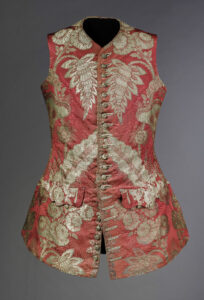
18th century vest. Image source: Five Minute History
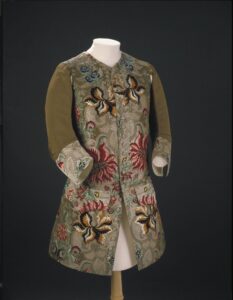
18th century waistcoat. Image source: V&A Museum
Victorian vests and waistcoats
The word “waistcoat” derives from the cutting of the coat at waist-level, since at the time of the coining, tailors cut men’s formal coats well below the waist. An alternative theory is that, as material was left over from the tailoring of a two-piece suit, it was fashioned into a “waste-coat” to avoid that material being wasted, although recent debate has cast doubt on this theory.
What is more likely is that culture simply changed in the Victorian era, necessitating a shorter vest that was easier to move around in. And why not do away with it all together? Well, you know those virtuous Victorians! Just as it was considered appalling for a woman to be seen outdoors without a hat or gloves, men were required by societal rule to wear something over their shirt sleeves.
Besides being shorter, Victorian vests saw a large shift from elaborate to understated, following the general trends in men’s clothing for the era. Whereas the 18th and early 19th centuries had celebrated the vest as the focus of an outfit, Victorian vests were viewed more as a sophisticated accent, and also used more to form a silhouette than they had been in early times.
Did you know that many men’s vests in the Victorian era were made with whale boning, similar to a corset?
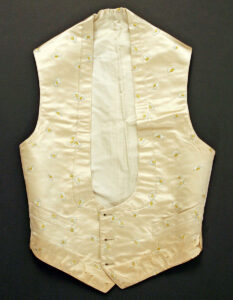
19th century men’s vest. Image source: MET Museum
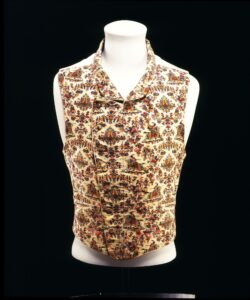
19th century vest. Image source: V&A Museum
Victorian women and vests
In Victorian times, we find examples of vest-like garments for ladies. Sometimes they are knitted, and sometimes elaborately embellished. Our pragmatic fore-mothers were never beyond adapting a piece of gentlemen’s clothing for their own use. Usually, these vests were worn in a casual setting, mostly when the lady was at home, while social visits usually called for the traditional long skirt with a fitted jacket or bodice.
Several bodices – most notably the “French Bodice” were made to appear as though a jacket was being worn over a vest; though in reality the “vest” was a panel sewn into the front of the bodice to appear as though it was a separate garment. In this way, the lady could have the appearance of a vest without the extra bulk that might have made her tiny waist appear larger.

Image source: MET Museum
Create a Victorian vest look of your own
View our entire collections of jackets and vests here.
by Sue McDonald
(updated December 2021 by Janice Formichella)
More Victorian fashion history
Elegance at Home: Victorian Wrappers
Victorian opera attire: a feast for the eyes


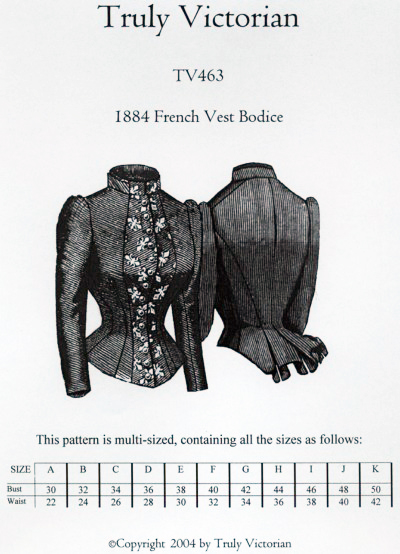
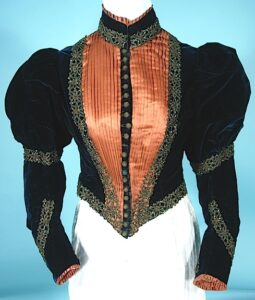
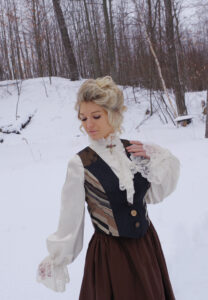
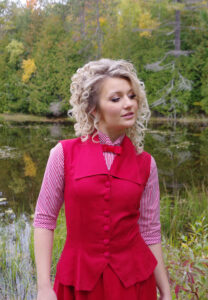












King Charles =1666? Not 1866.
Thank you for article on vests. They are clearly not the Victorian period our group re enacts and I should avoid further purchases. I will wear for late Victorian Bella Epoque events.
On a separate issue. The Union Pacific is celebrating 150 years since the Golden spike. There will be events all along the route of the Union Pacific. Would you be interested in addressing the costuming of that period?
I would like to see more paletots or other mantels. A sontag or two. And some more simple straw hats for summer wear. Likewise some indian cottons made up in summer wear. . Broadcloth is pretty warm in summer.and non natural fabrics lead to heat stroke. Beautiful examples available when I google 1850s summer dresses but I cant even find the fabric. Large pagoda sleeves transparent fabrics. Very simple designs. Interested in any of these ideas?